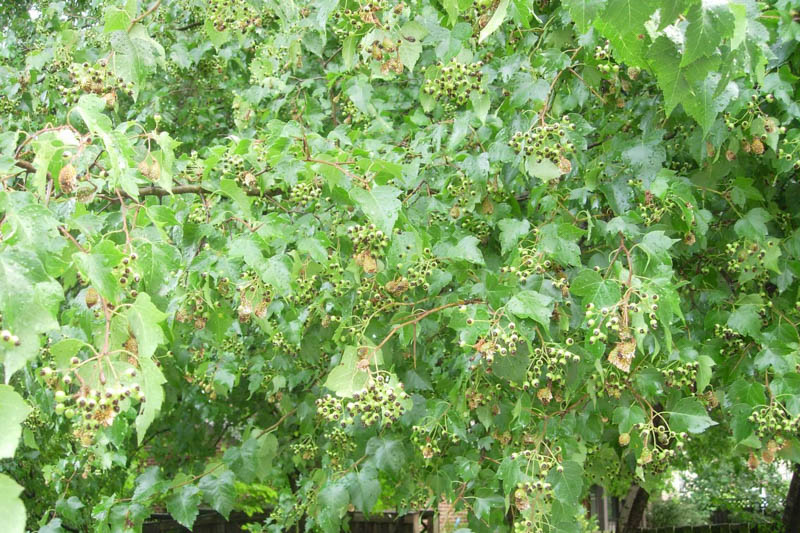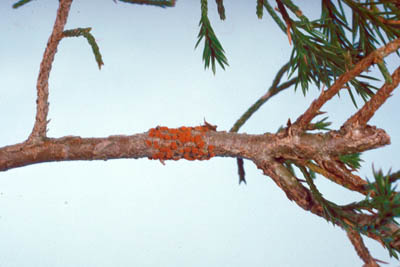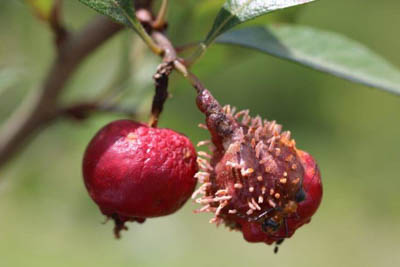How to Identify, Prevent, and Treat Quince Rust
Cedar-quince rust, caused by the fungus Gymnosporangium clavipes, requires two hosts to complete its life cycle: members of the Juniperus genus (such as eastern red cedar, J. virginiana) and plants within the family Rosaceae. While the disease is named for quince, it actually has a broader range of hosts within the Rosaceae family and affects:
The fungus alternates between these two host groups, with the junipers being the primary hosts where the pathogen overwinters and the Rosaceae family plants being the secondary hosts affected during the growing season. The wide range of potential hosts contributes to the disease’s prevalence and the difficulty in managing it in landscapes where these plants are present.
Cedar-quince rust spreads through a complex lifecycle.
Overwintering and Initial Spread: The fungus overwinters as galls on juniper trees. During wet, warm spring weather, these galls produce orange, gelatinous spore horns, which release spores known as teliospores. These spores germinate to produce basidiospores.
Transmission to Secondary Hosts: The basidiospores are carried by the wind to the secondary hosts in the Rosaceae family. This is a crucial point in the spread of cedar-quince rust because the fungus requires a secondary host to continue its lifecycle. Once the spores land on susceptible tissue of these plants, they germinate, infecting the plant and causing disease symptoms.
Spreading Back to Primary Hosts: Later in the season, the infected Rosaceae plants produce spores of their own, called aeciospores, which are then spread by the wind back to the juniper hosts. Upon reaching the junipers, they infect the trees, forming galls where the fungus will overwinter and begin the cycle anew the following spring.
The spread of cedar-quince rust is heavily dependent on environmental conditions, particularly moisture and temperature. Wet, warm springs are conducive to the production and dissemination of spores, thus increasing the risk of infection. Human activity, such as the movement of infected plants, can also contribute to the spread of the disease. Additionally, the proximity of the hosts to each other can facilitate the transmission of the spores, making the disease more prevalent in areas where junipers and susceptible Rosaceae plants are grown in proximity.
 Diseased Fruit on Hawthorn
Diseased Fruit on Hawthorn
Quince rust is mainly an issue in the eastern United States, where both the Rosaceae hosts and the alternate juniper hosts are present. The disease favors regions with temperate climates that experience cool, wet springs.
Cedar-quince rust presents distinct symptoms on its two different host plants.
 |
 |
Prompt identification of these symptoms is crucial for effective management and control of cedar-quince rust, especially since the disease can significantly impact the health and aesthetic appeal of the host plants, and in commercial settings, affect yield quality and quantity.
Controlling and preventing Cedar-Quince Rust involves integrated strategies since this pathogen requires two hosts to complete its life cycle. Here are measures you can take:
Cultural Control:
Physical Control:
Chemical Control:
Monitoring:
Remember, it’s essential to follow local regulations and guidelines when implementing disease control measures, especially when using chemical controls. Also, consider consulting with a local extension service or a plant health professional for identification and management advice tailored to your specific region.
Create a membership account to save your garden designs and to view them on any device.
Becoming a contributing member of Gardenia is easy and can be done in just a few minutes. If you provide us with your name, email address and the payment of a modest $25 annual membership fee, you will become a full member, enabling you to design and save up to 25 of your garden design ideas.
Join now and start creating your dream garden!
Create a membership account to save your garden designs and to view them on any device.
Becoming a contributing member of Gardenia is easy and can be done in just a few minutes. If you provide us with your name, email address and the payment of a modest $25 annual membership fee, you will become a full member, enabling you to design and save up to 25 of your garden design ideas.
Join now and start creating your dream garden!